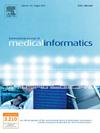比较逻辑回归和机器学习对肥胖风险预测的影响:一项系统综述和荟萃分析
IF 3.7
2区 医学
Q2 COMPUTER SCIENCE, INFORMATION SYSTEMS
International Journal of Medical Informatics
Pub Date : 2025-03-21
DOI:10.1016/j.ijmedinf.2025.105887
引用次数: 0
摘要
传统上,逻辑回归(LR)一直是预测二元健康结果的标准方法;然而,机器学习(ML)方法越来越受欢迎。目的比较ML和LR在肥胖风险预测中的作用,确定LR和ML的比较方式,并确定常用的ML方法。方法我们于2023年11月24日在PubMed、Scopus、Embase、IEEE Xplore和Web of Science数据库中进行综合检索,不限制发表日期。采用曲线下面积(AUC)对LR进行meta分析,对表现最佳的ML进行AUC,并将两种方法之间的AUC差异作为效果测量,以量化方法的总体预测性能。结果913篇摘要纳入了28篇研究。准确性和灵敏度是最常用的性能指标。超过一半的研究使用了AUC,在任何研究中都没有进行校准评估。决策树和增强算法是最常用的机器学习方法。75%的研究存在高偏倚风险。荟萃分析纳入了14项研究。LR的合并AUC为0.75 (95% CI 0.70 ~ 0.80), ML的合并AUC为0.76 (95% CI 0.70 ~ 0.82)。ML和LR之间的logit(AUC)总差为0.13 (95% CI -0.11至0.37)。结论ML和LR在预测肥胖风险方面无显著差异。然而,有必要提高研究报告的质量,使用更多的绩效指标,特别是校准,并在不同的人群中验证模型。本文章由计算机程序翻译,如有差异,请以英文原文为准。
Comparing logistic regression and machine learning for obesity risk prediction: A systematic review and meta-analysis
Background
Logistic regression (LR) has traditionally been the standard method used for predicting binary health outcomes; however, machine learning (ML) methods are increasingly popular.
Objective
This study aimed to compare the performance of ML and LR for obesity risk prediction, identify how LR and ML were being compared, and identify the commonly used ML methods.
Methods
We conducted comprehensive searches in PubMed, Scopus, Embase, IEEE Xplore, and Web of Science databases on 24th November 2023, with no restrictions on publication dates. Meta-analyses were performed to quantify the overall predictive performance of the methods using the area under the curve (AUC) for LR, AUC for the best performing ML, as well as the difference in the AUC between the two approaches as the effect measures.
Results
We included 28 studies out of 913 abstracts screened. Accuracy and sensitivity were the most commonly used performance measures. More than half of the studies used AUC, with no calibration assessment conducted in any of the studies. Decision trees followed by boosting algorithms were the most commonly used ML methods. Seventy-five percent of the studies were at high risk of bias. There were 14 included studies in the meta-analysis. The pooled AUC for LR was 0.75 (95% CI 0.70 to 0.80) and the pooled AUC for ML was 0.76 (95% CI 0.70 to 0.82). The pooled difference in logit(AUC) between ML and LR was 0.13 (95% CI -0.11 to 0.37).
Conclusion
We conclude that there is no significant difference in the performance of ML and LR for obesity risk prediction. However, there is a need for improved quality of reporting of studies, the use of more performance measures particularly calibration, and to validate models in different populations.
求助全文
通过发布文献求助,成功后即可免费获取论文全文。
去求助
来源期刊

International Journal of Medical Informatics
医学-计算机:信息系统
CiteScore
8.90
自引率
4.10%
发文量
217
审稿时长
42 days
期刊介绍:
International Journal of Medical Informatics provides an international medium for dissemination of original results and interpretative reviews concerning the field of medical informatics. The Journal emphasizes the evaluation of systems in healthcare settings.
The scope of journal covers:
Information systems, including national or international registration systems, hospital information systems, departmental and/or physician''s office systems, document handling systems, electronic medical record systems, standardization, systems integration etc.;
Computer-aided medical decision support systems using heuristic, algorithmic and/or statistical methods as exemplified in decision theory, protocol development, artificial intelligence, etc.
Educational computer based programs pertaining to medical informatics or medicine in general;
Organizational, economic, social, clinical impact, ethical and cost-benefit aspects of IT applications in health care.
 求助内容:
求助内容: 应助结果提醒方式:
应助结果提醒方式:


